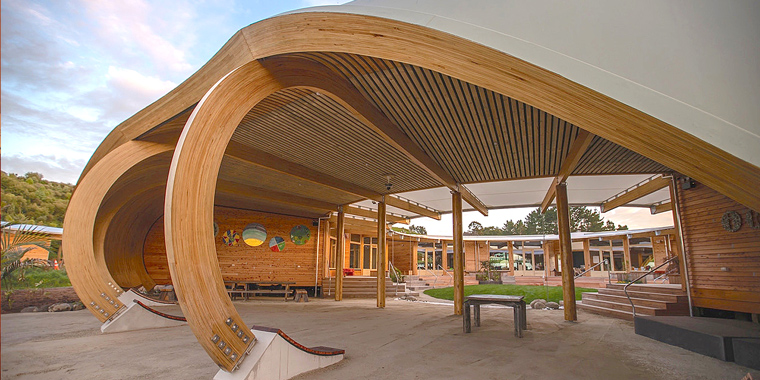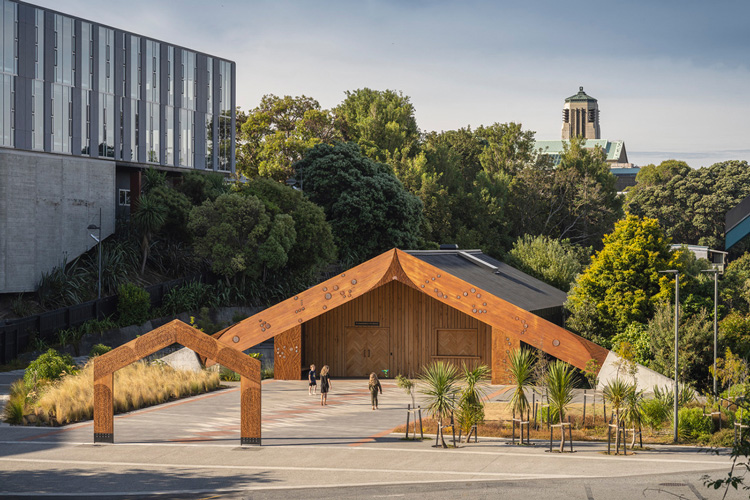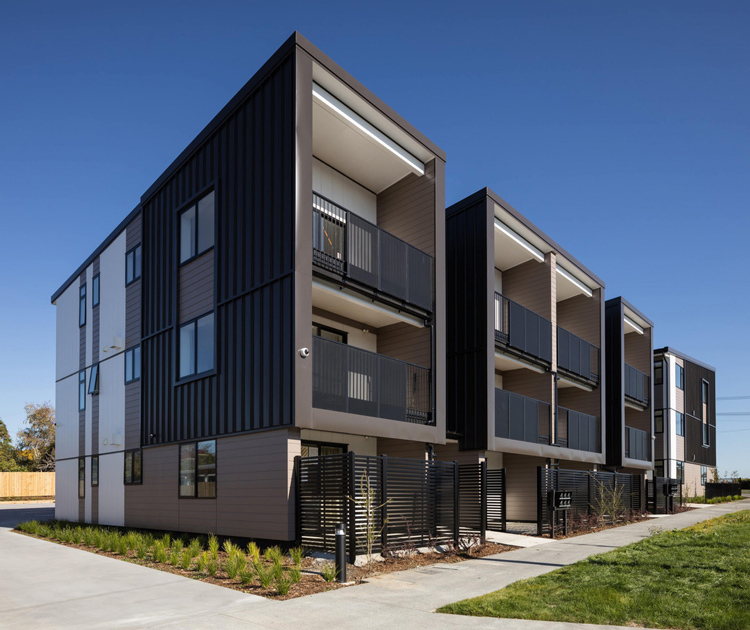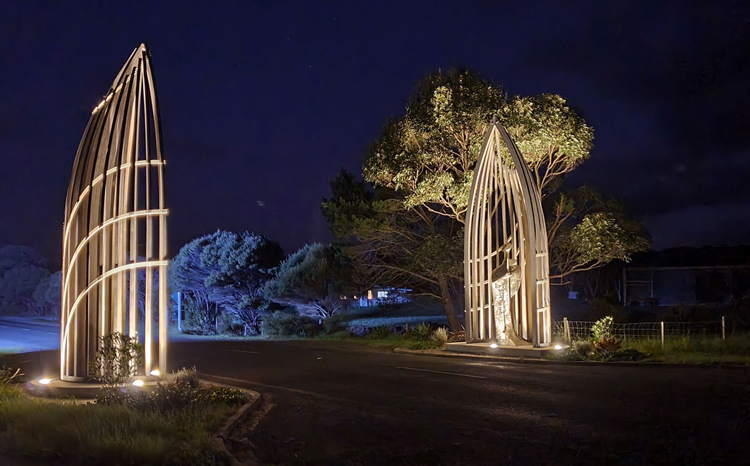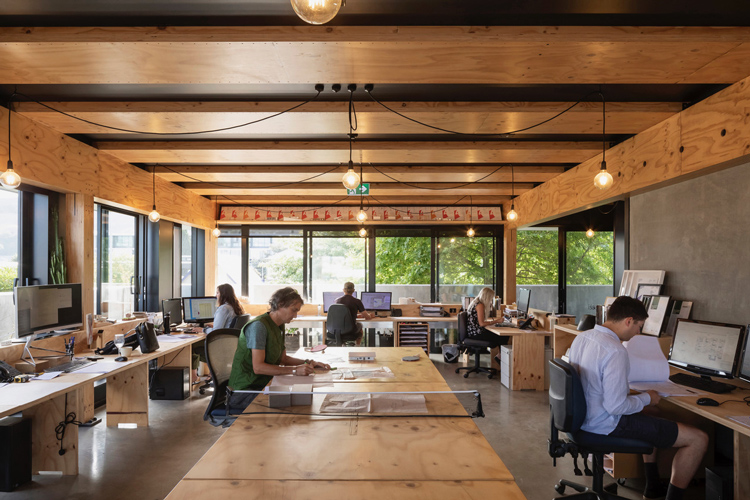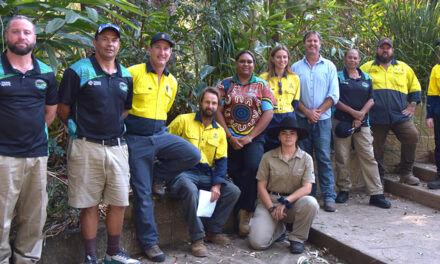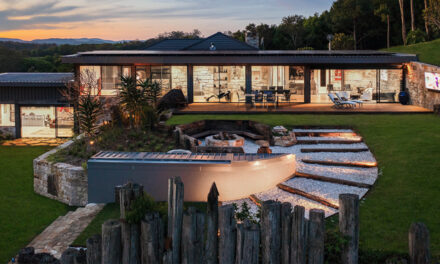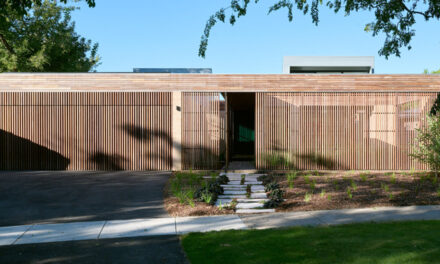NZ TIMBER DESIGN AWARDS RECOGNISE INNOVATION AND CREATIVITY
Te Rau Karamu Marae features totara – a native softwood suitable for laser cutting and CNC router work.
Image: Andy Spain
90 Carrington Road (social housing project): CLT was chosen
as the
primary structural material.
Image: RM Designs and Engco
Tomohai ki Ahipara (cultural gateway to Ahipara, Northland): winner of the People’s Choice Award.
Image: BJ Natanahira
Wall-E, winner of the Hybrid Building Award: notable for its fully expressed LVL post, beam and POTIUS floor elements.
Image: Patrick Reynolds
MAIN PIC – Green School – Kina: winner of the Commercial & Public Building Design Award and the Supreme Award.
Image: Charlotte Curd
After a keenly felt three-year absence, the NZ Timber Design Awards returned to centre stage late last week at a gala evening hosted by Timber Unlimited in Auckland.
Bringing together architects, designers, engineers and construction professionals, the awards were an opportunity to celebrate the redefining of timber as a modern building material.
“It’s no mistake we call ourselves Timber Unlimited,” says Dr Robert Finch, the organisation’s director. “The possibilities for timber aren’t limited to traditional uses any more. We all know timber can be aesthetically beautiful as well as being an impressive building material, but this time we’re also celebrating just how sustainable a sector this is.”
The 61 finalists chosen across 12 categories featured everything from residential and commercial architectural excellence, to innovative uses of engineered wood and new ways to use specialty timbers.
Determining the winners and runners-up required a profound understanding of architectural design, engineering skills and innovative thinking, as well as construction excellence.
Convening judge David Carradine, a senior structural research engineer with BRANZ (one of four judges selected for this year’s awards), says that for him, “There is no limit to what can be done with this material, especially combined with the advances in digital and manufacturing technologies that cater specifically to wood and engineered wood products.”
Mr Carradine was joined on the judging panel by Jan Stanway, Technical Director for WSP in New Zealand; Andrea Stocchero, senior analyst, Sector and Bio-economy at Te Uru Rakau – New Zealand Forest Service; and Judith Taylor, current President of the New Zealand Institute of Architects.
All judges felt the range of submissions demonstrated the innovation, dedication and creativity that exists across the New Zealand timber sector – from architectural and engineering design, manufacturing and fabrication, to “the builders and makers of these beautiful examples of what can be done with one of our greatest national treasures, namely timber”.
Prominent among the finalists was Green School – Kina, by Taranaki architects BOON – winner of the Commercial & Public Building Design category, and the overall Supreme Award. The judges agreed it was an exemplary project that demonstrated the beauty, efficiency and sustainability of timber … and was a clear winner.
The focal point of the project’s design is its curved glulam members comprising 24 curved portals, several complex eyebrow members, and curved purlins and battens.
Other prominent wood elements include a plywood-enclosed primary shell; New Zealand beech decking; Accoya window and door joinery; and internal cladding comprised of macrocarpa weatherboards.
The architects were keen to take advantage of the carbon sequestration ability of mass timber … while the design emphasised a minimal need for concrete – reserved for the four foundation blocks of the main arches.
“Through sustainable material selection, and innovative building techniques and products, Green School NZ buildings have been faster to build, higher performing and less wasteful than most others by quite a margin.”
Also worthy of mention is Te Rau Karamu Marae, by Te Kahui Toi and Athfield Architects – winner of the New Zealand Specialty Timber Award.
Located on Massey University’s Pukeahu Campus (Wellington), the marae makes extensive use of totara – a native softwood known for its remarkable characteristics, including durability, stability and appearance. And for its long tradition of use in structures and forms of great value to Maori.
Totara’s straight grain, softness and short fibres make it highly prized for carving, woodwork and joinery – an important consideration in its selection for the marae’s interior and exterior elements.
The full list of award winners and highly commended projects can be seen here.

